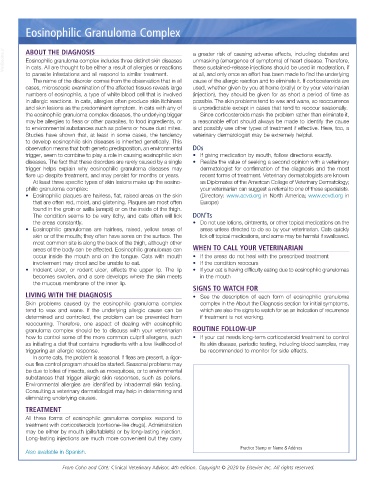Page 2990 - Cote clinical veterinary advisor dogs and cats 4th
P. 2990
Eosinophilic Granuloma Complex
VetBooks.ir ABOUT THE DIAGNOSIS a greater risk of causing adverse effects, including diabetes and
unmasking (emergence of symptoms) of heart disease. Therefore,
Eosinophilic granuloma complex includes three distinct skin diseases
these sustained-release injections should be used in moderation, if
in cats. All are thought to be either a result of allergies or reactions
to parasite infestations and all respond to similar treatment. at all, and only once an effort has been made to find the underlying
The name of the disorder comes from the observation that in all cause of the allergic reaction and to eliminate it. If corticosteroids are
cases, microscopic examination of the affected tissues reveals large used, whether given by you at home (orally) or by your veterinarian
numbers of eosinophils, a type of white blood cell that is involved (injection), they should be given for as short a period of time as
in allergic reactions. In cats, allergies often produce skin itchiness possible. The skin problems tend to wax and wane, so reoccurrence
and skin lesions as the predominant symptom. In cats with any of is unpredictable except in cases that tend to reoccur seasonally.
the eosinophilic granuloma complex diseases, the underlying trigger Since corticosteroids mask the problem rather than eliminate it,
may be allergies to fleas or other parasites, to food ingredients, or a reasonable effort should always be made to identify the cause
to environmental substances such as pollens or house dust mites. and possibly use other types of treatment if effective. Here, too, a
Studies have shown that, at least in some cases, the tendency veterinary dermatologist may be extremely helpful.
to develop eosinophilic skin diseases is inherited genetically. This
observation means that both genetic predisposition, an environmental DOs
trigger, seem to combine to play a role in causing eosinophilic skin • If giving medication by mouth, follow directions exactly.
diseases. The fact that these disorders are rarely caused by a single • Realize the value of seeking a second opinion with a veterinary
trigger helps explain why eosinophilic granuloma diseases may dermatologist for confirmation of the diagnosis and the most
flare up despite treatment, and may persist for months or years. recent forms of treatment. Veterinary dermatologists are known
At least three specific types of skin lesions make up the eosino- as Diplomates of the American College of Veterinary Dermatology;
philic granuloma complex: your veterinarian can suggest a referral to one of these specialists.
• Eosinophilic plaques are hairless, flat, raised areas on the skin (Directory: www.acvd.org in North America; www.ecvd.org in
that are often red, moist, and glistening. Plaques are most often Europe)
found in the groin or axilla (armpit) or on the inside of the thigh.
The condition seems to be very itchy, and cats often will lick DON’Ts
the areas constantly. • Do not use lotions, ointments, or other topical medications on the
• Eosinophilic granulomas are hairless, raised, yellow areas of areas unless directed to do so by your veterinarian. Cats quickly
skin or of the mouth; they often have sores on the surface. The lick off topical medications, and some may be harmful if swallowed.
most common site is along the back of the thigh, although other
areas of the body can be affected. Eosinophilic granulomas can WHEN TO CALL YOUR VETERINARIAN
occur inside the mouth and on the tongue. Cats with mouth • If the areas do not heal with the prescribed treatment
involvement may drool and be unable to eat. • If the condition reoccurs
• Indolent ulcer, or rodent ulcer, affects the upper lip. The lip • If your cat is having difficulty eating due to eosinophilic granulomas
becomes swollen, and a sore develops where the skin meets in the mouth
the mucous membrane of the inner lip.
SIGNS TO WATCH FOR
LIVING WITH THE DIAGNOSIS • See the description of each form of eosinophilic granuloma
Skin problems caused by the eosinophilic granuloma complex complex in the About the Diagnosis section for initial symptoms,
tend to wax and wane. If the underlying allergic cause can be which are also the signs to watch for as an indication of recurrence
determined and controlled, the problem can be prevented from if treatment is not working.
reoccurring. Therefore, one aspect of dealing with eosinophilic
granuloma complex should be to discuss with your veterinarian ROUTINE FOLLOW-UP
how to control some of the more common culprit allergens, such • If your cat needs long-term corticosteroid treatment to control
as initiating a diet that contains ingredients with a low likelihood of its skin disease, periodic testing, including blood samples, may
triggering an allergic response. be recommended to monitor for side effects.
In some cats, the problem is seasonal. If fleas are present, a rigor-
ous flea control program should be started. Seasonal problems may
be due to bites of insects, such as mosquitoes, or to environmental
substances that trigger allergic skin responses, such as pollens.
Environmental allergies are identified by intradermal skin testing.
Consulting a veterinary dermatologist may help in determining and
eliminating underlying causes.
TREATMENT
All three forms of eosinophilic granuloma complex respond to
treatment with corticosteroids (cortisone-like drugs). Administration
may be either by mouth (pills/tablets) or by long-lasting injection.
Long-lasting injections are much more convenient but they carry
Practice Stamp or Name & Address
Also available in Spanish.
From Cohn and Côté: Clinical Veterinary Advisor, 4th edition. Copyright © 2020 by Elsevier Inc. All rights reserved.

